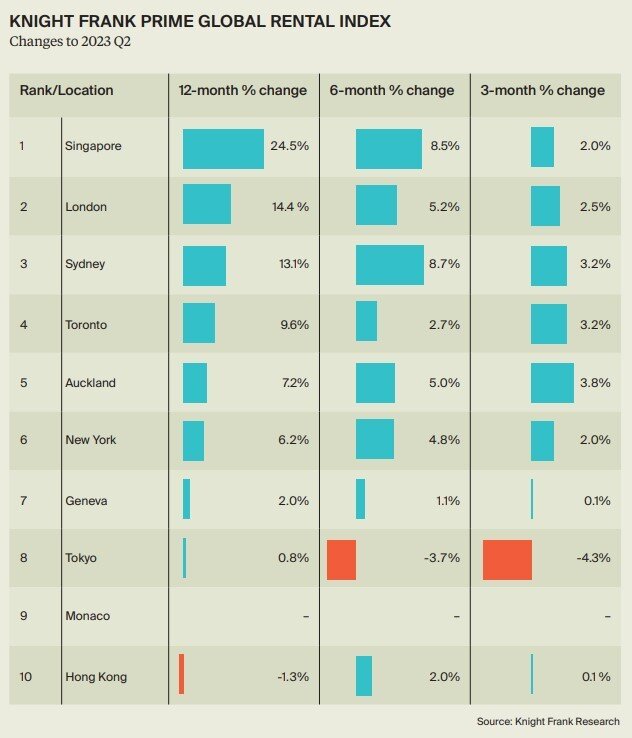Residential Real Estate News

Global Residential Rents Surge 300 Percent Their Prepandemic Growth Rates in 2023
Residential News » Singapore Edition | By Michael Gerrity | September 1, 2023 7:24 AM ET
Based on the 10 cities covered by Knight Frank's Prime Global Rental Index, global rental values rise 7.5% in the year to June. While this rate was down from the 8.2% seen in Q1, and lower still than the 12.2% growth reached in the first quarter of 2022 - which marked the peak of the post-pandemic rental boom, current growth remains well above trend.
Pre-pandemic, the ten years to 2020, saw average annual growth at 2.2%. Since the beginning of 2021 as the market recovered from the initial shock from Covid the index has seen average growth of 6.6%, with current growth almost three times above the prepandemic average.
The recovery in rents in the past two years has been remarkable. The overall index has risen 23% from Q1 2021 to date. Growth in specific cities has been even stronger - with New York, Singapore and London seeing rental growth of 56%, 53% and 51% respectively over the same period.

"Housing rents have risen by more than 50% in key global cities in just two years and are continuing to rise at three times their prepandemic rate. Affordability of housing is set to become the leading political issue within the next 12 months. The need for honest conversations about real supply-side solutions is becoming critical," says Liam Bailey, Knight Frank's global head of research.
Key drivers for rental growth are led by strong demand as residents return to cities following lockdowns, the affordability squeeze as prospective buyers are priced out of sales markets following rate hikes, and weak new supply following construction disruption through the pandemic.
Some of the PGRI growth hubs have seen a moderation in the pace of rent rises. In Singapore, annual growth eased from 31.5% last quarter to 24.5%; in London growth has decreased from 16.9% to 14.4%; and in New York, it has dropped from 10.6% to 6.2%.
While the index overall shows a fall in the pace of rental growth, certain cities are seeing the opposite trend. For instance, Sydney's annual growth has surged from 11.7% to 13.1% compared to the previous quarter. Similarly, Auckland, which had experienced a decline in rents last quarter, is now undergoing a yearly increase of more than 7%.
Knight Frank says Hong Kong saw an annual rental decline of -3.6% last quarter ease to -1.3% this quarter. This positive shift is attributed to a rebound in rental demand as more expats return to the city following the full reopening of the border in early January this year, as we discussed last quarter. The Top Talent Pass Scheme launched last December - targeting high-earning expats and foreign graduates from leading global universities - has enhanced rental demand - alongside a range of similar schemes aimed at attracting talent and workers. Hong Kong's population is estimated to have risen by 2% in the past 12-months - adding further pressure on rents.
New York's slowing in growth is attributed to affordability constraints - a process likely to be replicated in other growth cities. Despite the scarcity of available rental properties, the ability of tenants to keep bidding rents higher is beginning to wane as rental payments hit an ever-higher share of household income.
Knight Frank considers New York an interesting case study in the potential offered by supply side solutions to the rental market. There is much talk of office to residential conversions, especially of older office stock. However, the viability of many projects looks uncertain due to material and labor costs - which have experienced rapid inflation in recent years. Similar barriers to the delivery of rental property are present in many other key city markets. Sydney, for example, has experienced severe material and labor shortages in the construction industry, resulting in expensive renovations and long wait times for project delivery.
While the rate of growth in many cities will undoubtedly slow - lack of progress on new delivery means that tenants will face high rents for the foreseeable future, says Knight Frank.
Sign Up Free | The WPJ Weekly Newsletter
Relevant real estate news.
Actionable market intelligence.
Right to your inbox every week.
Real Estate Listings Showcase
Related News Stories
Residential Real Estate Headlines
- U.S. New-Home Sales Surge in August as Mortgage Rates Ease
- Despite Increased Foreign Buyer Activity, Miami Residential Sales Dip 11 Percent in August
- California Home Sales Enjoy Modest Uptick as Mortgage Rates Ease
- U.S. Home-Flipping Profits Sink to Lowest Level Since 2008 Financial Crisis as Costs Climb
- Why the World's Rich Are Flocking to Europe in 2025
- Federal Reserve Delivers First Rate Cut of 2025 as Mortgage Relief Proves Limited
- Homebuilder Sentiment Holds Steady in U.S. as Rate-Cut Bets Lift Outlook
- U.S. Mortgage Rates Experience Sharpest Weekly Drop in Over a Year
- U.S. Foreclosures Rise for Sixth Straight Month as Affordability Pressures Mount
- Black U.S. Homeownership Rate Falls to Two-Year Low as Job Losses Mount
- Las Vegas Home Prices Flatten as Listings Surge, Sales Slow
- Cooling Miami Housing Market Sees 16 Percent Annual Sales Drop in July
- U.S. Mortgage Delinquencies Uptick in June Amid Regional Pressures
- California, Florida Top U.S. Housing Markets Most at Risk of Downturn
- 30-Year Mortgage Drops to 6.56 Percent in Late August, Lowest Since October 2024
- Investors Maintain Elevated Role in U.S. Housing Market Despite Slight Pullback
- Pending Home Sales Show Mixed Signals as U.S. Buyers Remain Cautious
- Canadian Home Sales Extend Recovery in July
- U.S. Home Sales Rise in July as Buyers Gain More Bargaining Power
- Zombie Foreclosures Edge Up Across U.S.
- 2.6 Million Homes at Wildfire Risk Across 14 Western States in 2025
- One in Five Americans Willing to Trade Personal Safety for Home Affordability
- U.S. Home Price Growth Slows as Affordability Pressures Mount in 2025
- U.S. Mortgage Rates Dip to Four Month Low in Early August
- U.S. Mortgage Applications Rise in Late July, Breaking Four-Week Slump
- Hong Kong's Housing Market Stuck in Stalemate as Bulls and Bears Face Off
- U.S. Condo Market Struggles in 2025
- U.S. Pending Home Sales Remain Sluggish in June
- Los Angeles Area Wildfires Destroyed Nearly $52 Billion in Homes Last January
- Greater Palm Beach Area Residential Sales Slip in June Amid Growing Inventory
- Economic Resilience Lifts U.S. Housing Outlook Going Forward
- New Home Sales Stagnate as Affordability Struggles Continue in America
- U.S. Housing Market Slips in June as Prices Hit New Highs
- Florida, California Continue to Reign Supreme as America's Ultraluxury Housing Markets
- Caribbean Housing Market Evolves into Global Second-Home Hotspot
- U.S. Home Sales See Highest June Cancellation Rate on Record
- Orlando Housing Market Cools in June as Listings Slide, Sales Slow
- Private Credit Surges in 2025 as Real Estate Developers Bypass Banks
- U.S. Condo Market Suffers Sharpest Price Drops in Over a Decade as Buyers Retreat
- Rising Taxes, Insurance Costs Undermine the Stability of U.S. Homeownership








